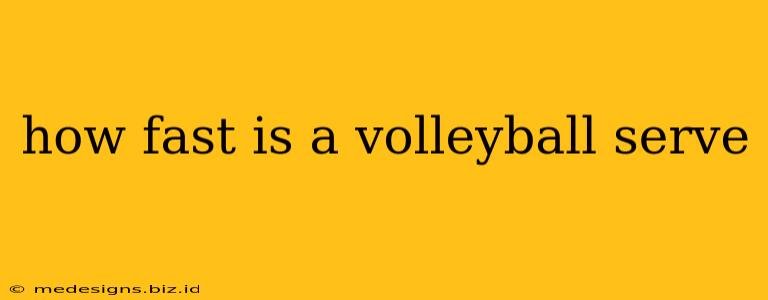How Fast is a Volleyball Serve? A Deep Dive into Speed and Technique
The speed of a volleyball serve is a crucial factor in determining its effectiveness. A powerful serve can disrupt the opposing team's reception, leading to scoring opportunities. But how fast is a typical volleyball serve, and what factors influence its speed? Let's delve into this exciting aspect of the sport.
Average Serve Speed
The average speed of a volleyball serve varies greatly depending on the player's skill level, the type of serve used, and even the specific game situation. However, a reasonable estimate for the average recreational player's serve would be between 30 and 40 mph (48 and 64 km/h).
Elite Player Serve Speeds: Reaching for the Top
Things get considerably faster at the elite level. Professional volleyball players, particularly those specializing in powerful serves, can consistently hit speeds significantly higher. We're talking 50-70 mph (80-112 km/h) and even beyond! Some exceptional serves have been clocked at speeds exceeding 80 mph (128 km/h). These speeds make the serve a potent offensive weapon, capable of directly scoring points or causing significant disruption in the receiving team's strategy.
Factors Affecting Serve Speed
Several factors contribute to the speed of a volleyball serve. These include:
-
Technique: Proper technique is paramount. A strong and efficient serving motion, including a powerful arm swing, leg drive, and core engagement, is essential for generating speed. Different serving techniques, like jump serves and float serves, also impact speed. Jump serves, for instance, generally produce higher speeds than float serves due to the added momentum from the jump.
-
Strength and Conditioning: Physical fitness plays a crucial role. Strength training, particularly focusing on leg and core strength, significantly impacts the power behind the serve. Endurance also matters, as maintaining consistent serve speed throughout a match requires stamina.
-
Equipment: The type of volleyball and the surface the player is serving from can also slightly affect the serve's speed. While this is not as significant as the other factors, minor differences can still be observed.
-
Game Situation: The pressure of the game situation itself may inadvertently affect a player's serve speed. In tense moments, a player may unconsciously exert more power, leading to a faster serve.
Types of Volleyball Serves and their Speed
Different serve types lead to different speeds. Let's quickly compare:
- Jump Serve: Known for its high speed and accuracy, this is often the fastest serve type.
- Float Serve: This aims for unpredictability rather than pure speed. While not as fast, its unpredictable trajectory can be very effective.
- Underhand Serve: Typically the slowest serve type, emphasizing consistency rather than power.
Conclusion: Speed Isn't Everything
While serve speed is a desirable attribute in volleyball, it's not the only factor determining a serve's effectiveness. A well-placed, unpredictable serve, even if not blazingly fast, can be equally, if not more, devastating. Ultimately, the most successful servers combine speed with accuracy, precision, and a strategic understanding of the game. Practice, honing technique, and building strength are key to improving serve speed and overall effectiveness.
